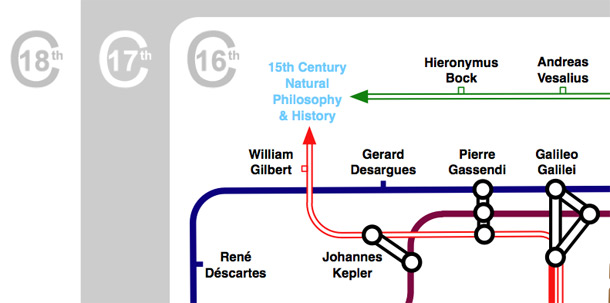Crispian Jago makes completely transparent attempts to get linked from blogs. The thing is, he keeps doing spectacular stuff!
This time it’s a metro-subway-style map showing scientists of the past 400 or so years. It’s wonderfully detailed! Here it is shrunk enough to fit on my meager 610-pixel wide blog:
[Click to unsubwaynate and get the 2Mb 4500 x 2700 pixel version.]
Each color track route represent a field of science - brown is chemistry, red is theoretical physical and quantum mechanics, and so on - and the time is concentric, with the 16th Century in the middle, and current time on the outside. Just like a subway map where there are transfer points, some people span more than one discipline, and you can see that as two circles connecting different tracks. Stephen Hawking, for example, is astronomy and physics. Here’s a zoom:

Cool, huh? Galileo was clearly a man of many hats. Lots of other scientists straddle multiple fields, but interestingly, the number of them dwindles with time. I’m no science historian - I’m not sure science existed before Twitter - but I imagine there are many reasons for this, not the least of which was that when science as a method was new, it was easier to make grand discoveries that spanned many different disciplines. It’s just plain old harder to do that these days. To make a name for yourself you have to be pretty good in a narrow field, and very few people have that sort of polymath capability when modern science is so deep and rich.
Note that for the 20th Century, Crispian started including a lot of popularizers of science as well. There may be a few names you recognize…
I expect this map will go viral once places like Geekologie and Boing Boing find it. Which they will. Get in on the coolness on the ground floor now. Or, of course, one flight lower.
Related posts:
- I am a skeptic chipmunk
- Easy-reading chiropractic libel for young readers
- Respect mah skeptical authoritay
- Taking the P out of pseudoscience